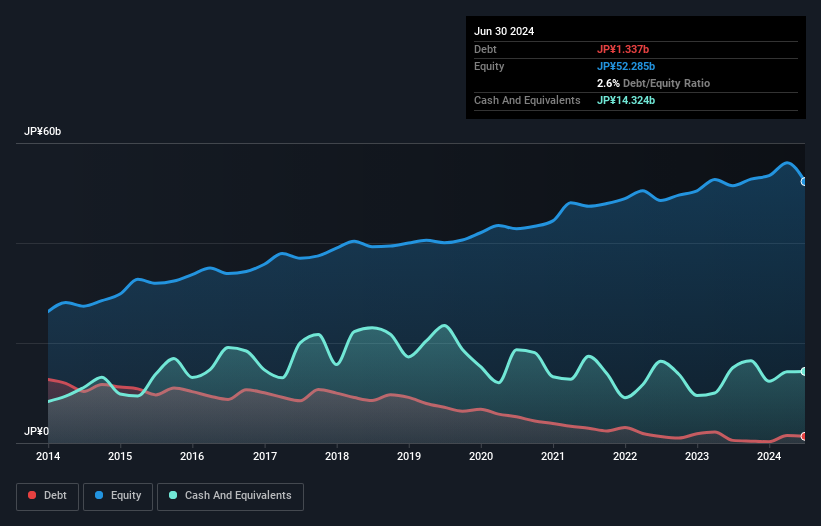
Some say volatility, rather than debt, is the best way to think about risk as an investor, but Warren Buffett famously said that 'Volatility is far from synonymous with risk.' So it seems the smart money knows that debt - which is usually involved in bankruptcies - is a very important factor, when you assess how risky a company is. Importantly, Toa Road Corporation (TSE:1882) does carry debt. But the real question is whether this debt is making the company risky.
When Is Debt A Problem?
Debt assists a business until the business has trouble paying it off, either with new capital or with free cash flow. If things get really bad, the lenders can take control of the business. However, a more frequent (but still costly) occurrence is where a company must issue shares at bargain-basement prices, permanently diluting shareholders, just to shore up its balance sheet. Of course, the upside of debt is that it often represents cheap capital, especially when it replaces dilution in a company with the ability to reinvest at high rates of return. The first step when considering a company's debt levels is to consider its cash and debt together.
View our latest analysis for Toa Road
How Much Debt Does Toa Road Carry?
The image below, which you can click on for greater detail, shows that at June 2024 Toa Road had debt of JP¥1.34b, up from JP¥524.0m in one year. However, it does have JP¥14.3b in cash offsetting this, leading to net cash of JP¥13.0b.

How Strong Is Toa Road's Balance Sheet?
According to the last reported balance sheet, Toa Road had liabilities of JP¥27.8b due within 12 months, and liabilities of JP¥3.91b due beyond 12 months. On the other hand, it had cash of JP¥14.3b and JP¥28.3b worth of receivables due within a year. So it can boast JP¥10.9b more liquid assets than total liabilities.
This excess liquidity suggests that Toa Road is taking a careful approach to debt. Due to its strong net asset position, it is not likely to face issues with its lenders. Simply put, the fact that Toa Road has more cash than debt is arguably a good indication that it can manage its debt safely.
Fortunately, Toa Road grew its EBIT by 4.1% in the last year, making that debt load look even more manageable. When analysing debt levels, the balance sheet is the obvious place to start. But you can't view debt in total isolation; since Toa Road will need earnings to service that debt. So if you're keen to discover more about its earnings, it might be worth checking out this graph of its long term earnings trend.
Finally, a company can only pay off debt with cold hard cash, not accounting profits. Toa Road may have net cash on the balance sheet, but it is still interesting to look at how well the business converts its earnings before interest and tax (EBIT) to free cash flow, because that will influence both its need for, and its capacity to manage debt. During the last three years, Toa Road generated free cash flow amounting to a very robust 82% of its EBIT, more than we'd expect. That puts it in a very strong position to pay down debt.
Summing Up
While we empathize with investors who find debt concerning, you should keep in mind that Toa Road has net cash of JP¥13.0b, as well as more liquid assets than liabilities. The cherry on top was that in converted 82% of that EBIT to free cash flow, bringing in JP¥6.8b. So we don't think Toa Road's use of debt is risky. Given Toa Road has a strong balance sheet is profitable and pays a dividend, it would be good to know how fast its dividends are growing, if at all. You can find out instantly by clicking this link.
Of course, if you're the type of investor who prefers buying stocks without the burden of debt, then don't hesitate to discover our exclusive list of net cash growth stocks, today.
Valuation is complex, but we're here to simplify it.
Discover if Toa Road might be undervalued or overvalued with our detailed analysis, featuring fair value estimates, potential risks, dividends, insider trades, and its financial condition.
Access Free AnalysisHave feedback on this article? Concerned about the content? Get in touch with us directly. Alternatively, email editorial-team (at) simplywallst.com.
This article by Simply Wall St is general in nature. We provide commentary based on historical data and analyst forecasts only using an unbiased methodology and our articles are not intended to be financial advice. It does not constitute a recommendation to buy or sell any stock, and does not take account of your objectives, or your financial situation. We aim to bring you long-term focused analysis driven by fundamental data. Note that our analysis may not factor in the latest price-sensitive company announcements or qualitative material. Simply Wall St has no position in any stocks mentioned.
About TSE:1882
Solid track record with excellent balance sheet and pays a dividend.
Market Insights
Community Narratives



